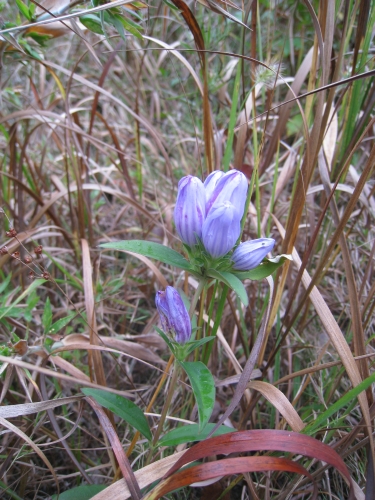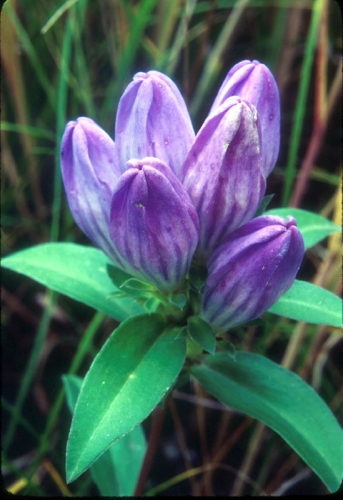Plants and Animals
Gentiana saponaria Soapwort gentian
Key Characteristics
Medium-sized forb (80 cm) of moist prairies; leaves opposite, lanceolate with ciliate margins; open tubular flowers blue with large erect lobes in between folds in the floral tube; borne in terminal clusters.
Status and Rank
US Status: No Status/Not Listed
State Status: X - Presumed extirpated (legally 'threatened' if rediscovered)
Global Rank: G5 - Secure
State Rank: SX - Presumed extirpated
Occurrences
| County | Number of Occurrences | Year Last Observed |
|---|---|---|
| Berrien | 1 | 1867 |
| Cass | 1 | 1867 |
Information is summarized from MNFI's database of rare species and community occurrences. Data may not reflect true distribution since much of the state has not been thoroughly surveyed.
Habitat
No habitat data are known for Michigan's sole collection of this species. Elsewhere in its range, this species occurs in a variety of moist prairie, thicket, and woodland habitats, usually on sandy soils. This species was last documented in Michigan in 1867.
Natural Community Types
- Lakeplain oak openings
- Lakeplain wet-mesic prairie
- Mesic sand prairie
- Oak barrens
- Wet-mesic sand prairie
For each species, lists of natural communities were derived from review of the nearly 6,500 element occurrences in the MNFI database, in addition to herbarium label data for some taxa. In most cases, at least one specimen record exists for each listed natural community. For certain taxa, especially poorly collected or extirpated species of prairie and savanna habitats, natural community lists were derived from inferences from collection sites and habitat preferences in immediately adjacent states (particularly Indiana and Illinois). Natural communities are not listed for those species documented only from altered or ruderal habitats in Michigan, especially for taxa that occur in a variety of habitats outside of the state.
Natural communities are not listed in order of frequency of occurrence, but are rather derived from the full set of natural communities, organized by Ecological Group. In many cases, the general habitat descriptions should provide greater clarity and direction to the surveyor. In future versions of the Rare Species Explorer, we hope to incorporate natural community fidelity ranks for each taxon.
Associated Plants
In the Chicago region this gentian occurs with prairie species such as little bluestem, false-indigo, tall coreopsis, rattlesnake-master, Indian grass, and Culver's root, as well as black and white oak.
Management Recommendations
If found to still be extant in the state, this species would likely require prescribed fire and other management that promotes and maintains prairie and savanna habitat.
Survey Methods
Random meander search covers areas that appear likely to have rare taxa, based on habitat and the judgment of the investigator.
-
Meander search
-
Survey Period: From first week of September to fourth week of October
-
References
Survey References
- Elzinga, C.L., D.W. Salzer, and J.W. Willoughby. 1998. Measuring and Monitoring Plant Populations. The Nature Conservancy and Bureau of Land Management, Denver. BLM Technical Reference 1730-1. 477pp.
- Goff, G.F., G.A. Dawson, and J.J. Rochow. 1982. Site examination for Threatened and Endangered plant species. Environmental Management 6(4): 307-316
- Nelson, J.R. 1984. Rare Plant Field Survey Guidelines. In: J.P. Smith and R. York. Inventory of rare and endangered vascular plants of California. 3rd Ed. California Native Plant Society, Berkeley. 174pp.
- Nelson, J.R. 1986. Rare Plant Surveys: Techniques For Impact Assessment. Natural Areas Journal 5(3):18-30.
- Nelson, J.R. 1987. Rare Plant Surveys: Techniques for Impact Assessment. In: Conservation and management of rare and endangered plants. Ed. T.S. Elias. California Native Plant Society, Sacramento. 8pp.
Technical References
- Cooperrider, T.S. 1995. The Dicotyledonae of Ohio Part 2. Linaceae through Campanulaceae. Ohio State University Press, Columbus. 656pp.
- Gleason, H. A., and A. Cronquist. 1991. Manual of Vascular Plants of Northeastern United States and Adjacent Canada. Second edition. The New York Botanical Garden, Bronx. 910pp.
- Gray, A. 1950. Gray's Manual of Botany; eighth ed. Van Nostrand Reinghold, New York. 1632pp.
- Holmgren, N.H. 1998. Illustrated Companion to Gleason and Cronquist's Manual. Illustrations of the vascular plants of Northeastern United States and adjacent Canada. New York Botanical Garden, Bronx. 937pp.
- Swink, F. and G. Wilhelm. 1994. Plants of the Chicago Region, 4th ed. Indiana Academy of Science, Indianapolis. 921pp.
- Voss, E.G. 1996. Michigan Flora. Part III. Dicots (Pyrolaceae-Compositae). Bulletin of the Cranbrook Institute of Science and University of Michigan Herbarium. 622pp.



